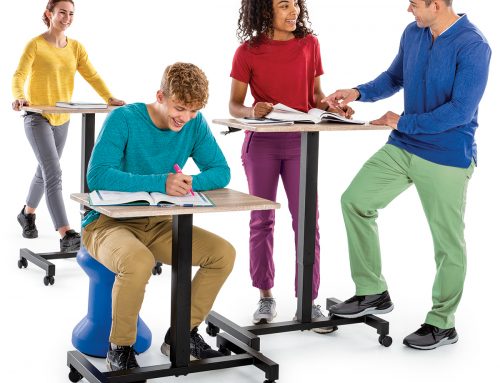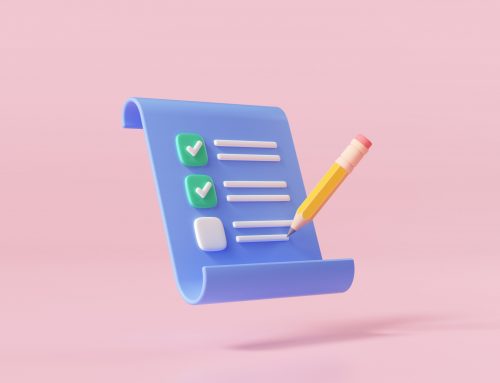Students have been sitting on their couches and running the roost of their homes since March. In the likely event that students will head back to classrooms in the fall, it will be important to provide an environment that helps them transition back to the classroom, keeps them engaged, and works in the favor of teachers everywhere.
Kinesthetic furniture allows students to incorporate their need for movement into the classroom environment. Students have been working in spaces that are far less structured than a traditional classroom, let alone the “new normal,” social distancing. Movement will be reduced, outdoor playground activity could be limited, and physical education seems to have a glaring barrier in front of it as people grapple with how to let students interact with one another.
The benefit of a wobble seat or standing desk can significantly decrease the potential challenges of returning to the classroom this fall. Standing desks have been shown to increase engagement and efficiency by 45% in a study out of Texas A&M among adults and ranges from 15-25% in students. Wobble stools increase positive posture and allow for students to fidget and move in their space. The positive posture of a wobble stool and standing desk increase blood flow to the brain which can result in the brain’s ability to create neurons that stimulate and support learning.
Rather than return students to static stations with limited movement, let’s put as many stools and standing desks into classrooms as possible. Let’s help our educators through the difficult transition ahead by providing students with an outlet for their restlessness. Let’s make sure we keep learning as a priority by providing students with tools necessary to engage and focus.
Through a Teacher’s Lens
I recently interviewed a Special Education Middle School Teacher, Angela Stark, who is also a blog author for Moving Minds.
What do you anticipate the fall is going to bring?
Angela: Returning to schools in the fall will be especially challenging for teachers and students this year. Students are going to be used to moving whenever they want around their house, studying while sitting on an exercise ball or while walking, playing for several hours a day, etc.
As we return to school, we are going to have to minimize student’s movement and engagement with peers. This is going to be extremely hard. Students are going to be made to sit even more than they did at home. No more active lessons moving around the classroom because of the limitations surrounding social distancing.
How can kinesthetic furniture help?
Angela: We as educators are going to have to change how we keep kids’ brains engaged during learning. I am thankful because I purchased active seating for my health classroom back in February 2019. My students have Ergo Chairs, Stability Ball Mobile Chairs, CushionED Active Seats, and a SaddlED Active Desk Chair. Every student will have to ability to strengthen their muscles as well as engage their brain to stay focused and will be able to retain more content. Unfortunately, this is only 45 minutes of their day. Imagine what an impact we could have on our students if more classrooms have active seating for all students.
What is your biggest concern about returning to the classroom?
Angela: My biggest concern is how to keep everyone safe. I am worried about students’ physical and mental health. If we make kids sit in one spot all day with very little movement to preserve social distancing, and we do not get the kids outside or regularly moving, kids are going to struggle with their health. How are kids going to get their 60 minutes of physical activity? With health at the forefront of the COVID-19 conversation, now is the time for us to make sure health and healthy behaviors in our classrooms are present.
What kinds of student behaviors do you think we should anticipate?
Angela: I believe kids are going to struggle with anxiety and depression. These issues were already present before the pandemic but now, with months of isolation, I think these issues will present much more often. These behaviors can present in a variety of ways such as meltdowns, explosiveness, fidgeting, lack of focus, and more. Allowing kids to move via active seating could make a huge difference as we transition back to schools in the fall. I think students are going to need to be able to harness excess energies and I’d rather they focused those energies through positive movement versus negative behaviors.
Do you think kinesthetic furniture can help with social distancing in a classroom space? How so?
Angela: Yes, I think it can be a huge health benefit for our students and preserve social distancing at the same time. A lot of kinesthetic furniture is super easy to move. Whether being lightweight or having wheels, or even rolling it across a room, students will be able to easily space 6 feet apart while also having the opportunity to move throughout a lesson. Being able to move around a classroom might provide our students with some sense of normalcy, which is crucial for the transition back. This will help students stay focused and engaged but will also work to strengthen their core muscles at the same time. All of this can promote health in our new environments.
Will outdoor class be something worth considering?
Angela: I think creating outdoor spaces would be a great idea for our students as we get back to school. Creating spaces with socially distanced seating and shade structures would decrease risk and allow a positive impact from nature. We are going to create 3 to 4 outdoor classrooms for students at my school because I believe this will be the best learning environment at the moment.

Matt Levine is the Brand Manager for Moving Minds. He holds an Master of Education, Educational Leadership and Policy Studies from Iowa State University and a Bachelor of Arts in Psychology from Drake University. Matt came to Moving Minds in 2018 after working in higher education for more than 10 years, serving time in student life and activities and leadership development programming. When Matt is home and not chasing his two kids Ellie and Will around the yard (who are typically chasing their dog Ruxin around the yard), he enjoys cooking with his wife Anne, and embracing the outdoor activities that Minnesota offers!





Leave A Comment